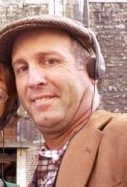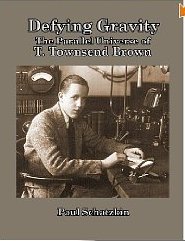Publisher: Paul Schatzkin
Year: 2009
ISBN: B00266OWY6
Websites: www.ttbrown.com/book/index.html
Unlike Alice's Adventures In Wonderland, this is not a fairy tale, though at times it seems like one. So perhaps it is fitting to begin by saying:
Once upon a time, there really was a person named T. Townsend Brown. We know his name. We know where he was born and where he was raised. We know who his parents were, his wife, his children and even his grandchildren. We know most of the places where he lived and there were literally dozens of them. We know where died, and where he is buried.
But that's about all we really know. Beyond that, the man is a ghost, a zephyr, a myth.
Most of the useful details about the life and times of T. Townsend Brown have vanished or been deliberately hidden. Behind a heavy veil of classified military research, covert intelligence operations, legendary experiments with flying discs, lost notebooks, unverifiable claims and fantastic possibilities, an incredible story lurks.
"The Universe is filled with magical things," wrote science fiction pioneer Eden Phillpotts, "patiently waiting for your wits to grow sharper." All the arrows in Townsend Brown's life point to just such a magical cosmos. Like stones hurled across the surface of a mountain lake in the early morning dew, the story points in the life of Townsend Brown all skip across the surface of our consciousness and disappear into a shroud of mist. But if we focus our vision just... so, and look into the mist with fresh eyes, we can see where the stone goes, and see the ripples from where it splashes.
Townsend Brown or, Dr. Brown a his many fans and those close to him still like to call him, despite his lack of academic credentials lived an extraordinary life, and it is time his story was told.
Somehow, the central mysteries of the past century nuclear physics, relativity, quantum mechanics, UFOs and the clandestine operations of the military industrial complex all appear to converge in the life of this one extraordinary man. The few minor accounts of his life already in circulation are largely filled with the sort of vague details that only amplify the mystery that surrounds him. It is time that some semblance of the larger picture however imperfect or incomplete be compiled. - From the Preface
Pages: 296
Publisher: Teamcom Books / Tanglewood Books
Year: 2002 / 2004
ISBN: 0976200007
ISBN: 978-0976200000
ISBN: 1928791301
ISBN: 978-1928791300
Copyright 2002 Reed Business Information, Inc. --This text refers to an out of print or unavailable edition of this title.
From Booklist
Philo T. Farnsworth had one of his first insights into electronic television's design while watching a horse-drawn mower on a farm. It is remarkable enough that a boy should have such an inspiration, let alone that so primitive a technology would influence so advanced an instrument. But such insights occurred regularly throughout his life to a man not only obsessed with transmitting pictures over wireless airwaves but also one possessing a mind able to absorb and resolve every sort of theoretical and technical issue. Schatzkin, although clearly in awe of his subject, finds room to document some of Farnsworth's less amiable characteristics, such as his bouts of drinking and depression, his neglect of wife and family, and his persistent rivalry with RCA's Samoff, who was equally committed to developing television. Schatzkin keeps the pace moving quickly and doesn't let himself get bogged down in the scientific details. The result is a readable, if not particularly analytical, biography of the man whose invention truly revolutionized the world. Mark Knoblauch




